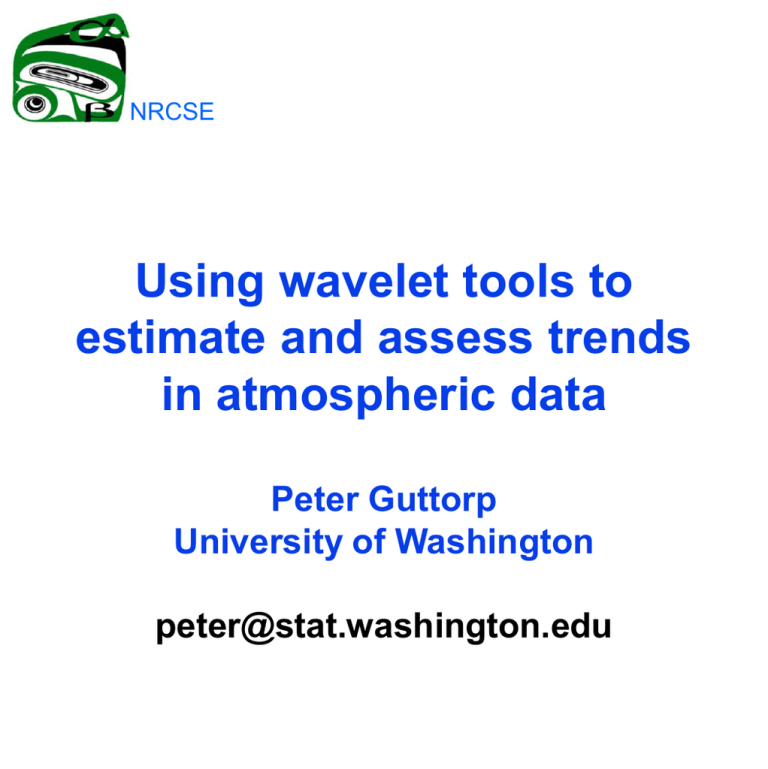Using wavelet tools to estimate and assess trends in atmospheric data Peter Guttorp
advertisement

NRCSE
Using wavelet tools to
estimate and assess trends
in atmospheric data
Peter Guttorp
University of Washington
peter@stat.washington.edu
Collaborators
Don Percival
Chris Bretherton
Peter Craigmile
Charlie Cornish
Outline
Basic wavelet theory
Long term memory processes
Trend estimation using wavelets
Oxygen isotope values in coral cores
Turbulence in equatorial air
Wavelets
Fourier analysis uses big waves
Wavelets are small waves
Requirements for wavelets
Integrate to zero
Square integrate to one
Measure variation in local averages
Describe how time series evolve in time
for different scales (hour, year,...)
or how images change from one place
to the next on different scales (m2,
continents,...)
Continuous wavelets
Consider a time series x(t). For a scale l
and time t, look at the average
t 2
1
A(,t)
x(u)du
t
2
How much do averages change over
time?
D(,t) A(,t ) A(,t )
2
2
1 t
1 t
x(u)du x(u)du
t
t
Haar wavelet
D(1,0) 2 (H) (u)x(u)du
1
2 , 1 u 0
1
(H)
(u) , 0 u 1
2
0, otherwise
where
Translation and scaling
(H)
1,t
(u) (H) (u t)
(H)
,t
(u)
1 (H) u t
(
)
Continuous
Wavelet Transform
Haar CWT:
(H)
W(,t) ,t
(u)x(u)du D(,t)
Same for other wavelets
W(,t) ,t (u)x(u)du
where
1 u t
,t (u)
Basic facts
CWT is equivalent to x:
d
1
x(t)
W(,u) ,t (u)du 2
C 0
CWT decomposes energy:
x2 (t)dt
energy
0
W2 (,t)
2
C
dtd
Discrete time
Observe samples from x(t): x0,x1,...,xN-1
Discrete wavelet transform (DWT) slices
through CWT
restricted to dyadic scales tj = 2j-1, j = 1,...,J
t restricted to integers 0,1,...,N-1
Yields wavelet coefficients Wj,t W(t j ,t)
J
Think of rt Wj,t as the rough of the
j1
series, so s t x t rt is the smooth
(also called the scaling
filter).
A multiscale analysis shows the wavelet
coefficients
for each scale, and the
smooth.
Properties
Let Wj = (Wj,0,...,Wj,N-1); S = (s0,...,sN-1).
Then (W1,...,WJ,S ) is the DWT of X =
(x0,...,xN-1).
(1) We can recover X perfectly from its
DWT.
(2) The energy in X is preserved in its
DWT:
N1
J
2
2
2
2
X xi Wj S
i0
j1
The pyramid scheme
Recursive calculation of wavelet
coefficients: {hl } wavelet filter of even
length L; {gl = (-1)lhL-1-l} scaling filter
Let S0,t = xt for each t
For j=1,...,J calculate
L1
Sj,t glSj1,2t1l mod(N2 j )
l0
L1
Wj,t hlSj1,2t1l mod(N2 j )
l0
t = 0,...,N 2-j-1
Daubachie’s LA(8)-wavelet
Oxygen isotope in coral
cores at Seychelles
Charles et al. (Science, 1997): 150 yrs
of monthly d18O-values in coral core.
Decreased oxygen corresponds to
increased sea surface temperature
Decadal variability related to monsoon
activity
1877
Multiscale analysis
of coral data
Decorrelation properties of
wavelet transform
Long term memory
Coral data spectrum
What is a trend?
“The essential idea of trend is that it
shall be smooth” (Kendall,1973)
Trend is due to non-stochastic
mechanisms, typically modeled
independently of the stochastic portion
of the series:
Xt = Tt + Yt
Wavelet analysis of trend
Significance test for trend
Seychelles trend
Malindi coral series
Cole et al. (2000)
194 years of d18O isotope from colony
at 6m depth (low tide) in Malindi, Kenya
4.7
4.1
1800
1900
2000
Confidence band
calculation
Malindi trend
Air turbulence
EPIC: East Pacific Investigation of
Climate Processes in the Coupled
Ocean-Atmosphere System
Objectives: (1) To observe and
understand the ocean-atmosphere
processes involved in large-scale
atmospheric heating gradients
(2) To observe and understand the
dynamical, radiative, and microphysical
properties of the extensive boundary
layer cloud decks
Flights
Measure temperature, pressure,
humidity, air flow going with and
across wind at 30m over sea surface.
Wavelet and bulk
zonal momentum flux
Wavelet measurements are “direct”
Bulk measurements are using empirical
model based on air-sea temperature
difference
-1
0
1
2
3
4
5
Latitude
6
7
8
9
10
11
12
Wavelet variability
Turbulence theory indicates variability
moved from long to medium scales
when moving from goingalong to going
across the wind.
Some indication here; becomes very
clear when looking over many flights.
Further directions
Image decomposition using wavelets
Spatial wavelets for unequally spaced
data (lifting schemes)
References
Beran (1994) Statistics for Long Memory
Processes. Chapman & Hall.
Craigmile, Percival and Guttorp (2003)
Assessing nonlinear trends using the
discrete wavelet transform. Environmetrics,
to appear.
Percival and Walden (2000) Wavelet
Methods for Time Series Analysis.
Cambridge.

